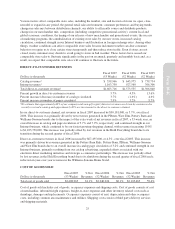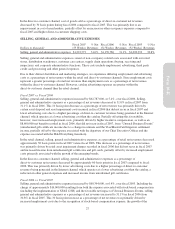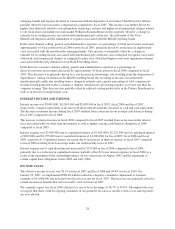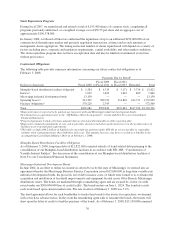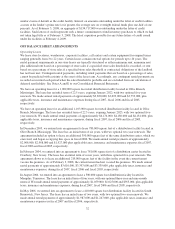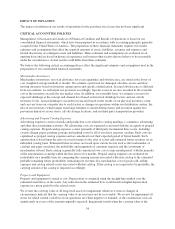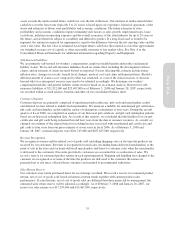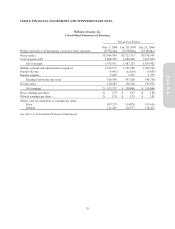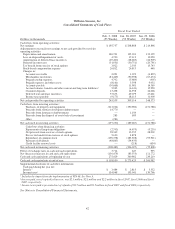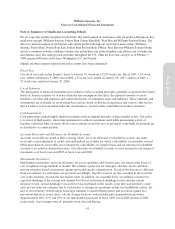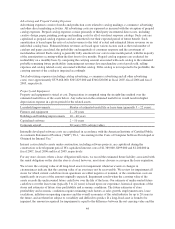Pottery Barn 2007 Annual Report Download - page 44
Download and view the complete annual report
Please find page 44 of the 2007 Pottery Barn annual report below. You can navigate through the pages in the report by either clicking on the pages listed below, or by using the keyword search tool below to find specific information within the annual report.IMPACT OF INFLATION
The impact of inflation on our results of operations for the past three fiscal years has not been significant.
CRITICAL ACCOUNTING POLICIES
Management’s Discussion and Analysis of Financial Condition and Results of Operations is based on our
consolidated financial statements, which have been prepared in accordance with accounting principles generally
accepted in the United States of America. The preparation of these financial statements requires us to make
estimates and assumptions that affect the reported amounts of assets, liabilities, revenues and expenses and
related disclosures of contingent assets and liabilities. These estimates and assumptions are evaluated on an
ongoing basis and are based on historical experience and various other factors that we believe to be reasonable
under the circumstances. Actual results could differ from these estimates.
We believe the following critical accounting policies affect the significant estimates and assumptions used in the
preparation of our consolidated financial statements.
Merchandise Inventories
Merchandise inventories, net of an allowance for excess quantities and obsolescence, are stated at the lower of
cost (weighted average method) or market. We estimate a provision for damaged, obsolete, excess and slow-
moving inventory based on inventory aging reports and specific identification. If actual obsolescence is different
from our estimate, we will adjust our provision accordingly. Specific reserves are also recorded in the event the
cost of the inventory exceeds the fair market value. In addition, on a monthly basis, we estimate a reserve for
expected shrinkage at the concept and channel level based on historical shrinkage factors and our current
inventory levels. Actual shrinkage is recorded at year-end based on the results of our physical inventory count
and can vary from our estimates due to such factors as changes in operations within our distribution centers, the
mix of our inventory (which ranges from large furniture to small tabletop items) and execution against loss
prevention initiatives in our stores, off-site storage locations, and our third party transportation providers.
Advertising and Prepaid Catalog Expenses
Advertising expenses consist of media and production costs related to catalog mailings, e-commerce advertising
and other direct marketing activities. All advertising costs are expensed as incurred with the exception of prepaid
catalog expenses. Prepaid catalog expenses consist primarily of third party incremental direct costs, including
creative design, paper, printing, postage and mailing costs for all of our direct response catalogs. Such costs are
capitalized as prepaid catalog expenses and are amortized over their expected period of future benefit. Such
amortization is based upon the ratio of actual revenues to the total of actual and estimated future revenues on an
individual catalog basis. Estimated future revenues are based upon various factors such as the total number of
catalogs and pages circulated, the probability and magnitude of consumer response and the assortment of
merchandise offered. Each catalog is generally fully amortized over a six to nine month period, with the majority
of the amortization occurring within the first four to five months. Prepaid catalog expenses are evaluated for
realizability on a monthly basis by comparing the carrying amount associated with each catalog to the estimated
probable remaining future profitability (remaining net revenues less merchandise cost of goods sold, selling
expenses and catalog related-costs) associated with that catalog. If the catalog is not expected to be profitable, the
carrying amount of the catalog is impaired accordingly.
Property and Equipment
Property and equipment is stated at cost. Depreciation is computed using the straight-line method over the
estimated useful lives of the assets. Any reduction in the estimated lives would result in higher depreciation
expense in a given period for the related assets.
We review the carrying value of all long-lived assets for impairment whenever events or changes in
circumstances indicate that the carrying value of an asset may not be recoverable. We review for impairment all
stores for which current cash flows from operations are either negative or nominal, or the construction costs are
significantly in excess of the amount originally expected. Impairment results when the carrying value of the
34



